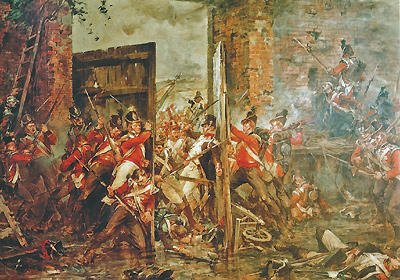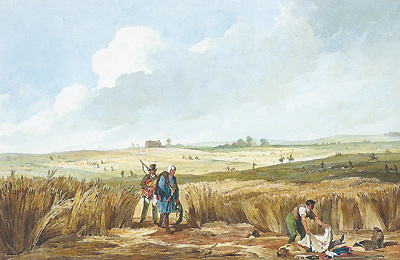|
WHY IS WATERLOO SO IMPORTANT?
by Lieutenant General Sir Barney White-Spunner KCB CBE
formerly The Blues and Royals
|

The gates at Hougoumont Farm
|
2015 is a year of anniversaries. Agincourt, that most English of battles, was fought 600 years ago, famously on St Crispin’s Day, 25th October, as Henry V would have us all remember. Our Scottish brethren might point out that 300 years ago the Old Pretender struck a blow for Scottish independence, or actually more a blow for the return of the Stuarts, in his abortive rebellion. One hundred years ago our grandfathers and great grandfathers volunteered in their thousands to fight in the trenches on the Western Front and battled the Turks at Gallipoli. Yet it is the events of 16th to 18th June 1815 that possibly stand foremost in our national memory, and not just because we have a station and a bridge to remind us of them. That extraordinary period, the 100 Days that started on 1st March 1815 when Napoleon landed at Fréjus in southern France to his final defeat at Waterloo, just south of Brussels in the newly united Netherlands, exercise a lasting fascination. How many of us, if we are being honest with ourselves, can actually name the battles in France in 1915, who commanded which army and what the outcome was, although admittedly it was usually stalemate? Who can honestly name the opposing commanders at Gallipoli or tell us who commanded the English right wing at Agincourt? But all of us know that at Waterloo it was the great Duke of Wellington who defeated Napoleon and that he managed to do so because Blucher’s Prussians arrived on the battlefield just in time.
Waterloo is so much a part of our national psyche for two reasons. First, it ended the long war with France, the Napoleonic Wars, which everyone except Napoleon had assumed had finished in 1814 with his first exile. There is a tendency today to regard Napoleon’s wars as in some way glamorous or chivalric, but the reality for early nineteenth century Europe was very different. Seven million Europeans were killed as a direct result of warfare in the 23 years between 1792 and Waterloo in 1815 and a fifth of all European battles fought between 1490 and Waterloo took place in that very short period. Societies were mobilized and nations broken up, economies ruined and families devastated in a manner similar to that which Europe experienced between 1939 and 1945. Britain escaped invasion then just as we did in 1940 but the impact of the wars on people at home was in many ways as far reaching.
The second reason that Waterloo is such an important battle for us is because of the heroism of the young men who fought there. There is a myth that the battle was some sort of final clash of titans, the superb military machine created by Napoleon pitted against a British army hardened to perfection by Wellington in the Peninsula. That was not the case. The French army had been neglected by the Bourbons during the eleven months of Napoleon’s first exile and even his administrative and military genius could not recreate in one hundred days the regiments that had brought him victory at Jena and Austerlitz, quite apart from the fact that he had squandered so many of them, and most of their horses, in Russia. The victorious British Peninsula army that had battled its way from Portugal into France had returned home in 1814 and much of it had promptly been disbanded; defence cuts when the fighting is done are not just a modern phenomenon. 47,000 soldiers had been discharged by the end of 1814. Of those that remained, many of the experienced first battalions of the infantry regiments had been deployed overseas, largely to America where we were engaged in one of our more injudicious campaigns, and several further afield. The army left in the British Isles consisted of the less experienced second or third battalions of infantry, most of the cavalry, it being too expensive to ship overseas, and a fair bit of artillery, although the gunners had been cut by 7,000.
When news of Napoleon’s landing reached London there was, consequently, something approaching panic in the War Office. It was clear that the newly restored Emperor would most likely threaten the Netherlands, where there was a small British and Prussian garrison under the flawed command of The Prince of Orange. There was an urgent need to assemble an army to reinforce them and to do so quickly. The Austrians and Russians were mobilizing large armies but they would take time, and the danger was that Napoleon would defeat the British and their German and Netherlands allies, and the Prussians, in detail before the central powers arrived. In March and April there was, therefore, a concerted recruitment campaign, and the response was considerable. Many came forward from the Militia, where they had at least had some military training, and more volunteered from civilian life. The result was that the regiments, batteries and battalions that were successively shipped to Ostend that spring were both young (the average age at Waterloo was to be twenty two) and untried, with only a third having previous combat experience, a proportion which fortunately included the majority of the officers and NCOs.
This was not then the army of hardened criminals flogged into battle by an authoritarian duke as the myth would have us believe. Rather, much of it was composed of volunteers who joined up from a sense of patriotic duty. There were, of course, many who had other reasons for joining, whether a search for adventure and an escape from unrewarding civilian jobs, or to make a clean start after things had gone wrong, but they were essentially an improvised force who responded to a national call to arms, and it is this that makes their performance so extraordinary. Lots has been written about Wellington and Napoleon but not enough about these young ploughboys and weavers who were in action for the first, and often the only, time and who stood in those obstinate squares, who rode in those decimated cavalry regiments or manned the mauled gun batteries. They were essentially a modern army, who had much more in common with the men who would deploy to the Netherlands again ninety nine years later, or in 1944, than they had with their pipe clayed and bewigged forebears of the 1790s. They were the force who shaped the pattern of the modern British army, and we owe them much. It is the stories of those soldiers I have written about in my book Of Living Valour - who they were, where they came from, their families, their reaction to the fighting and what happened to them afterwards.
Many served in the regiments that now comprise the Household Division. The Household Cavalry, 1st and 2nd Life Guards and The Blues, formed, with the King’s Dragoon Guards, the Household Brigade, one of two brigades of heavy cavalry. The Royal Dragoons were in the second heavy brigade, the Union Brigade, so called because they served alongside the Scots Greys and the Inniskilling Dragoons. The First Infantry division was a Guards Division, with the second and third battalions of 1st Foot Guards forming one brigade and the second battalions of the Coldstream and 3rd Guards forming the second. Together with their integral artillery they were just over 4,000 men. Many Household Cavalry and Guards officers were also present in other roles; indeed, Wellington had such a predilection for using 1st Guards officers as Staff Officers and ADCs that the Prince Regent had to warn him of the damage he was doing to the battalions.
The part our regiments played in the battle is now deservedly the stuff of legend. Whether charging into d’Erlon’s massed infantry columns, attacking the heavily armoured Cuirassiers, defending Hougoumont, arguably the key action of the battle, standing in the rapidly diminishing squares against repeated charges by Ney’s cavalry, or the final advance against Napoleon’s Imperial Guard, the Household Cavalry and Foot Guards were pivotal to the allied victory and took casualties that sadly corresponded to their actions. The 2nd Life Guards lost a greater proportion of their strength than any other regiment present. We owe them much. Not only did they finally end the Napoleonic menace and allow Europe to enjoy the fruits of the agricultural and industrial revolutions, but it is their legacy on which our regiments and the modern British Army is founded.
Waterloo is not that distant a memory. There are people alive today whose grandparents fought there although they were born too late actually to have talked to them about their experiences. The last veterans only died in the 1890s and the last British woman to witness the battle, Elizabeth Watkins, died in 1903. Her father, Daniel Gale, from Beaminster, was one of the many who volunteered in March 1815 and she accompanied him to the Low Countries as was common practice for military families. We have a huge number of personal letters, diaries and records about the battle. Many have been published, but there are also many that have not. I have used a combination of both in my research and, as I have worked on this book, I am left with a deep interest in and abiding respect for those who fought.
Of Living Valour by Barney White-Spunner is published by Simon & Schuster at £25 and reviewed in the Book Reviews section.

Burying the dead, whose bodies, stripped naked by the locals, were tossed into enormous pits which remain unmarked to this day |
|
|


